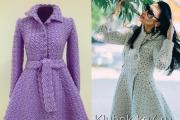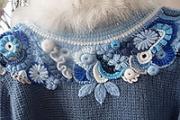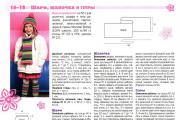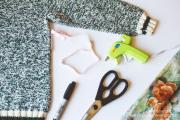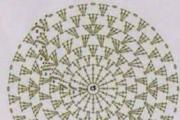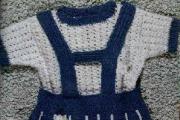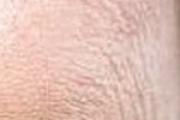Artistic applique made of fabric. Application with children
Even small children over 3 years old can make appliqué from scraps of fabric if you help them at first. Simple children's creativity the child will like it. And it will be beneficial; this type of creativity develops perseverance and accuracy. You can start with a small picture by choosing a simple drawing. The applique can then be placed in a frame, and for beauty, trimmed with contrasting threads or outlined with special fabric paint along the contour of the design. You can buy a painting inexpensively and make a copy of it from fabric.
What fabrics are suitable for applique
Start with a single piece applique, choosing a piece of cotton fabric with a large image. For example, with a bird or a horse, large flower or a heart. Cut out this design from fabric and paste it onto the base.
Different fabrics have different structures and change their shape after washing, i.e. stretched differently. Therefore, before use, the fabric must be soaked in warm water and dry carefully by ironing with a hot iron through a dry cloth. If the fabric is starched, its edges will not fray, which is very important when working. Starch natural fabric can be liquid paste from potato starch.
Then it must be ironed with a hot iron wrong side. Synthetic fabric should be sprinkled with gelatin solution and not ironed.
To work on fabric, you need scissors, a needle, pins, a hoop, a thimble, thread and fabric.
With small children, it is better to make the applique using glue. Cut out the details of your applique from pre-starched fabric, generously coat the reverse side with BF glue and stick it onto the base of your picture. For better drying, cover the applique with a damp cotton cloth for 2 hours and place a warm iron on top.
Older children, after 5 years, can make appliqués using polyethylene for gluing. Applique parts are also made from pre-starched cotton fabric. They do it this way: Place several layers of newspaper under the base of the picture. Place thin plastic film on newspapers, and applique blanks on top of the polyethylene. Cover the whole thing with a sheet of white paper and iron it with a hot iron. The fabric will easily stick to the base, and excess film will remain on the paper.
The finished, already dried applique can be decorated by sewing buttons or beads, bows or other decorative elements.
To obtain a relief appliqué, place cotton wool or pieces of foam paper under the cut out parts of the applique. Such applications look very beautiful, but they are difficult to clean.

















Applications using figurines taken from a child’s hand as parts are very interesting, bright and colorful.
Place the child’s hand on a dark cloth, trace its outline with chalk and cut out the resulting figure. The hand can be used as a trunk. All that remains is to glue or sew on the green crown.
The task can be complicated by applying not only the contour of the hand, but also the foot. The foot can be used as a tree trunk, and the two hands as branches. Cut the crown from green fabric.
Children really like palm and finger appliques. The details of such applications are figures obtained from children's palms.
The applique from your baby's palm will remain as pleasant memory about a sweet, unforgettable childhood that can be pasted into a nursery with photographs.

In order to make similar applications in the form of trees (or any others at your request), you will need:
Burlap or canvas fabric
Choice of: wooden frame, two wooden slats or a sheet of cardboard
Glue Moment or PVA
Scraps of various fabrics
Before you begin, choose how your work will be displayed. To do this, you can stretch the canvas fabric over wooden frame, simply nail the top and bottom edges to the wooden slats, or pre-glue the fabric onto the cardboard for rigidity.

Calleen's idea was that the tree trunks would look like the outlines of her children's hands. Each child has his own tree.

This is how a tree trunk was made from brown striped fabric.

For leaves, it is best to take several types of plain fabric and several types of fabric with a pattern.

These are the leaves Calleen’s kids had.

Little Molly glues tree leaves.

The tree crown is already ready!

Now all that remains is to glue the trunk - and the tree is ready. This fabric painting can decorate your home too!
And here's another option

More complex applique ideas
You can make your own fabric appliqués in the form of panels, bedspreads, tablecloths, curtains, pillowcases. You can add pieces of leather, suede, fur, buttons, beads, and beads to the fabric as decoration.
The fabric for a panel or bedspread should be thick enough, for a tablecloth or curtain it should be lighter.
The background fabric must be secured to the board using pushpins. Attach the appliqué parts to the base with pins.
After you are sure that the parts of your future product are correctly selected and correspond to your plan, you need to sew or glue these parts to the base. It is better to sew using stitches. This method of attachment will also serve as decoration. Individual parts can be decorated decorative cord.
Applique parts can be glued using polyethylene and a hot iron. You can do this as follows. Place several newspapers on the table, on them - the base of the applique, then - plastic film, on it - the details of the applique. Cover the top with a white sheet of paper and iron it all with a hot iron. The appliqué parts will be glued to the base, and the remaining excess polyethylene must be removed.
Applications using fabric look good on curtains, bedspreads, tablecloths, and oven mitts. Bright colors can be used to decorate children's clothing: dresses, T-shirts, sweaters or pants.
Working on applique using a variety of fabrics is a very exciting and interesting activity for children. Bright fabrics with colorful drawings on them fascinate the child, causing a whole storm different emotions- from tenderness to delight. And the process of work itself captivates the baby, captivates him, allowing him to receive great feelings of joy and satisfaction.
To add variety to home interior Together with your child, you can make a decoration for curtains from fabric. To do this, you need to decide which flower will best suit your curtains and the decor as a whole. Next, cut out two identical flowers from cardboard, only one from cardboard and the other from fabric, glue or sew the parts together and secure them to the curtains.



< 





















Even small children over 3 years old can make an applique from scraps of fabric. A child will love this simple children's creativity. And it will be beneficial; this type of creativity develops perseverance and accuracy. You can start with a small picture by choosing a simple drawing. The applique can then be placed in a frame, and for beauty, trimmed with contrasting threads or outlined with special fabric paint along the contour of the design.
Applications can be either simple or complex, consisting of several or many elements. But in any case, the elements: appliqués - flowers, trees, birds, animals, etc. - must be stylized, without unnecessary details, with a clear, regular outline.
For fabric appliqué materials can be all kinds of natural and synthetic fabrics different textures - smooth, fleecy, shiny, matte, as well as leather, fur, felt, felt.
In order to prevent the edges of the fabric from fraying when cutting out the applique and sewing it on, the flap is starched: flaps from chintz, satin, paper - with a paste made from potato flour (wrung dry and ironed from the inside out with a hot iron); rags of silk, cambric, lace, synthetic fabrics - with gelatin (dry rags are stretched on a board and sprayed with a gelatin solution, then dried, but not ironed).
With small children, it is better to make the applique using glue. Cut out the details of your applique from pre-starched fabric, generously coat the reverse side with BF glue and stick it onto the base of your picture. For better drying, cover the applique with a damp cotton cloth for 2 hours and place a warm iron on top.
Older children, after 5 years, can make appliqués using polyethylene for gluing. Applique parts are also made from pre-starched cotton fabric. They do it this way: Place several layers of newspaper under the base of the picture. Place thin plastic film on newspapers, and applique blanks on top of the polyethylene. Cover the whole thing with a sheet of white paper and iron it with a hot iron. The fabric will easily stick to the base, and the excess film will stick to the paper.
Often examples for appliqué are illustrations from magazines, postcards, and ornaments on objects of decorative and applied art. Many needlewomen try to make illustrations smaller or larger. Those who cannot draw can translate the drawings into cells in accordance with a given scale. To do this, the illustration is divided into equal square cells, and on a sheet of paper where the drawing should be enlarged or reduced, a grid is made of the same number of squares, but larger or smaller size, and the drawing is transferred to them. You can transfer individual elements of a drawing onto paper to then obtain patterns for these elements.
To perform a complex applique, you must make a sketch of the applique and cut out individual parts. The sketch is necessary for control. Prepared paper patterns are applied to the fabric, attached to it with pins, and if the figure is large and complex, it is basted and then cut out of the fabric along the contours of the paper pattern. For some patterns, it is necessary to make increases in those places where one part overlaps another, for example, if you need to attach a jacket with a skirt, then an increase should be made to the end of the jacket and a skirt should be sewn onto it. If identical figures appear several times in a pattern, then the material can be folded several times and several copies can be cut out at once using a paper pattern. It is imperative to cut shapes, especially large ones, along the grain thread, otherwise they will become deformed (stretched).
The cut out figures are laid out on the base in the right places of the sketch, the shape, background compatibility and color of the figures are clarified, after which they begin to attach the applique to the base.
The following materials and equipment are usually used in the fabric appliqué technique: PVA glue, paper, scraps of fabric, scissors, beads, braid, etc.
In general, there are several techniques for making appliqués using fabric. Children's appliqués made of fabric, as a rule, are made by gluing, because it is still difficult for children to hold a needle in their hands, and most importantly, to handle it carefully. Therefore, as a material for trial crafts, you can choose felted wool or other lightweight and easy-to-glue material. First, it is determined what kind of pattern will be made; a design is drawn on a paper or cardboard base. Thin fabric should be cut along the grain to avoid pulling out the flap (Fig. 1).
Rice. 1. Fabric applique "Snail"
Another option that is suitable for doing with children is gluing the fabric onto an adhesive base, such as non-woven fabric. To do this, you can take a base from a self-adhesive film and lay it adhesive cloth, and cover the top with a cloth of the desired color. This entire fabric “sandwich” should be ironed. Then with reverse side. Where paper base, the contours of the design are marked, the base layer is cut out and carefully removed. And the shred is applied to a piece of fabric and also ironed. Likewise all the details are collected future work into a large drawing.
They will help you decorate the craft various buttons, beads, sequins, but the main decoration will be skillfully selected fragments of fabric - real handicraft.
Is your imagination failing and you no longer know what to do with your child? In this article you will find several unusual and interesting ideas for applique that will suit both toddlers and older children.
Applique is a long-standing pastime not only for many children, but even for adults. After all, gluing something onto a base or sewing it on is very interesting. And now there are many more different materials, which can be successfully used in applications and create wonderful and unusual works.
Often the works use all sorts of elements that are easy to find in any home or even on the street: pebbles, shells, beads, seed beads, pieces of regular or lace fabric, buttons and many other different things.
Subjects for creating applications can be very diverse:
- these could be your favorite cartoon characters
- favorite animals or toys
- wildlife
- different holidays
Paper applique
Application – Cat in the meadowMost often when we're talking about about applications with children, we mean specifically paper applique. And this is not just so, because paper can be found in any stationery store, and the variety of its types is quite large.
- The paper is bright and colorful, which really attracts the child to work with it.
- She might be different textures and forms
- It is easy to roll, fold, cut out any shape from it and glue it to a paper base
- Well, the most important thing is that paper is an environmentally friendly and, accordingly, safe material, therefore it is great for creative activities even with the smallest children
The influence of appliqué classes on child development
Thanks to the application, children gain the following skills:
- master movement coordination
- develop fine motor skills of the hands
- learn the basics of composition
- learn colors and how they can be combined
- study different textures
- develop observation and imagination
- learn to fantasize
Appliqué work promotes the development of a child’s thinking processes; he learns to analyze and compare real objects and animals with crafts made with you. A child, working with an applique, makes a whole from several parts and learns to divide the whole into components.

 Application with pasta and beans
Application with pasta and beans - Like any other type of creativity, applique helps the development of speech, when adults discuss with the child the crafts they create, explain what they are doing and why, and what the end result is. By working together, children engage in dialogue and increase their erudition
- And of course this good option spending time together with your child, which will help you establish and strengthen emotional contact
- Below we offer you ideas for crafts using the applique technique. Suggested Examples of varying complexity and require creation different quantities time. Therefore, choose works according to the child’s age and help him create them.
- It will be good if you invite your child to change the composition, come up with something of his own - this will help him develop his imagination and creative abilities
Materials for paper applique
To make the work look beautiful, you need to carefully cut necessary elements and also carefully glue them to the base, but beauty also depends on the materials chosen.
The assortment of paper in stores is very large, but not all of it is suitable for appliqué work, and you can make a mistake when choosing glue. Please note the material selection guidelines below.


Paper and cardboard for applique
It is better to choose paper that is not very thin, but very thick paper will not work either. You can take either matte or glossy paper; it can be textured or smooth.
Choose paper that suits your idea. But please note that glossy paper will show traces of glue and fingerprints, so it is better to give preference to matte paper, then the work will look neater.
- First, try working with colored paper, which is produced specifically for the printer. It is in every store and happens different colors. It is quite good in density and matte
- More experienced creators can use coated paper, it is also available in sets of different colors. This paper is glossy and quite thick.
- Textured paper will help to emphasize any details of the craft. Choose paper of a suitable thickness and desired texture, for example, with some kind of embossing or velvet effect
- It still happens foil paper, with its help you can make very realistic windows in your craft, or water. This paper is usually produced in medium weight, which is perfect for appliqué. Sometimes such paper also has a holographic effect.


- A very convenient type of paper for applique is self-adhesive paper, however, you still need to look for it, and color palette very poor. This paper is convenient because it does not require glue to be glued, thanks to which it adheres perfectly evenly to the base.
- Drawing paper well suited for creating templates, because... it is dense and its edges do not wrinkle
- Cardboard It is good to use as a basis for work; it can be either white or colored. Due to its density, it will not wrinkle when parts are glued to it. Also choose the cardboard that is most suitable for your idea; it can be either matte or glossy.
Glue and other applique tools
To create an applique, the necessary parts are cut out of paper and glued to the base cardboard. You can cut parts along the outer edge with scissors, but to cut holes inside it is better to use a stationery knife.
The glue also needs to be selected correctly so that it does not cause deformation of the paper and the craft does not lose its appearance.
- Scissors choose good ones, they should cut the paper well and be sharp. They should be comfortable for the child to hold. It is better if you have scissors with straight blades for cutting parts in a straight line, and second ones with rounded blades, which are easy to cut along a curved path.
- In order to cut anything inside the part, you will need stationery knife. They are also easy to cut along the contour of the template
- Metal ruler useful for cutting straight lines knife
- You will need cutting mat stationery knife, it will protect your furniture from scratches
- You can find it in stores figured hole punches, with their help you can make various figures from colored or white paper with one click on it. The variety of types of hole punches is quite large; they differ in size and shape. With their help, you can make a bunch of butterflies and flowers for a forest clearing in a matter of minutes, rather than cutting them out with scissors for half a day

 Figured hole punch - Butterfly
Figured hole punch - Butterfly - They will make the edge of the paper into an interesting shape, following a certain pattern. There are also many of them different types, so to speak, for every taste


- Rubber glue very convenient for application, because If the part is not glued correctly, before the glue has dried, you can carefully remove it and glue it in another place. Also, traces of glue can be easily removed with a regular eraser. The only drawback of this glue is its smell, so it is better not to use it with kids
- For small children you can buy glue stick. It practically does not deform the paper, but traces of it still remain
- Glue with brush will be very convenient for kids to use, because they will be very interested in dipping the brush into a jar and applying glue to the part
Additional materials and techniques for application
To make the application special and interesting, you can use other materials.
- A highlight will be added, for example, by such a detail as artificial plastic eyes on an animal, which will move when the position of the picture changes.
- Small details in the work do not have to be cut out; they can be drawn with a felt-tip pen or pencil
- An acrylic outline will help highlight the necessary elements of the craft.
- You can use beads and paper lace in the applique; these materials will make the work interesting and unusual.
- You can put the craft in a frame if it turns out very beautiful, it is dear to you as a memory, or it was made as a gift


Circle applique ideas
An unusual applique idea is to use only cut out paper circles. If you make all the details from circles, you will get a very interesting and unusual work.
The child will really like this activity, especially if he sees how simple circles different sizes turn into a cute cat or bird.








Napkin applique ideas
For applications you can use even the most regular napkins. They come in different colors, although their choice is not large; as a rule, these are primary colors and several additional shades. This technique is very simple and can be done even with three-year-old children.


Applique using napkin balls is a very exciting activity for children. This technique stimulates development well fine motor skills, because Rolling balls is a very painstaking job.
Making this craft is quite simple:
- prepare the drawing, apply it to the base
- the details of the drawing should not be small, there must be enough space for gluing the balls
- you will need PVA glue and scissors
- prepare colorful napkins
- select the size of the frame to frame your finished work
Napkins can also be replaced with corrugated paper, but this is not necessary, because... You can find these napkins in any store. The only thing better than corrugated paper is the wide variety of colors.


The drawing can not be applied to cardboard, but printed on a printer and glued to the base. While it is drying, you need to prepare multi-colored balls.
To do this, cut napkins or corrugated paper into squares of the same size and roll them into balls. For such work you will need a lot of balls, and their number will also depend on the size of the picture and the size of the balls themselves.


Using PVA glue, napkins need to be glued to the picture, some details can be drawn with a marker or felt-tip pen, it all depends on your imagination and the desire of the young master.
The background of the work can also be made from balls of a suitable color.


Frame your work and use it to decorate a room or other room in the house or garden. This picture will also be a good gift for relatives and close people, for example, on the holiday of February 23 or March 8.
Button applique ideas
All children love buttons. Probably, every child more than once found his mother’s box with them and put things in order in it, choosing the ones he liked the most. Therefore, an applique with buttons will be interesting to any child.


From the age of two, a child can already do a simple picture by gluing buttons in the shape of a flower or a butterfly to the base.
With older children, you can make a hot stand by gluing buttons to leather or a piece of felt.


With older children, buttons can be glued with glue, but when working with little ones, it is better to glue double-sided tape to the buttons. If there are a lot of them and there is no way to stick tape on each one, you can glue plasticine onto the cardboard, and then press the buttons onto it. It is better to use glossy cardboard, because... stains from plasticine may appear on the matte finish.






Cereal application ideas
Cereals can be successfully used not only in the kitchen, but also in creativity. Cereals make wonderful and unusual paintings and crafts.
Just like with the napkins, you'll need a base image. This can be any image drawn, printed or cut out from a coloring book. The main thing is that the picture does not show small parts, then its elements can easily be covered with different cereals.


- Apply glue to the picture with a brush. If you will be used different cereals, do not apply glue to the entire drawing at once
- First coat one part with glue and let the child sprinkle cereal on it. You can use your fingers to press it slightly onto the base. Anything that doesn’t stick, shake it back into the plate.
- If there are several elements, apply glue to them and sprinkle with cereal one by one - this will help make the work neat


You can use a wide variety of cereals, and you can even paint them in various colors gouache. And it's very easy to do:
- dilute the gouache with a little water
- paint the cereal with a brush
- place on a bag or stationery file in one layer
- let dry


The second method is suitable if you need to color a lot of grains, and it is good because the colored grains do not stain your hands when further work with them:
- Place the cereal in a container, rice works well
- fill it with water and add enough gouache to get a bright, rich color
- leave to stand for 12 hours
- drain the water and dry in one layer


Applications made from natural materials
Autumn gives us a lot natural material, which can be used in various crafts. From simple leaves, which are lying on the streets, you can make a lot of interesting things, including applications. They make funny little people, various animals, landscapes and even plot paintings.
Collecting material for applications is also very fun and simple, because you can find leaves while walking in the park.


You can make a hedgehog from maple leaves, fish from birch, and oak leaves resemble a tree.
Some details of the work can be completed with felt-tip pens or paints.


You can cut out the necessary parts from the leaves, i.e. use not a whole leaf, but a cut out element. Use leaves of different colors.
You can pre-dry the leaves or put them in a book for a while to straighten them out. You can also dry them by ironing them through a sheet of paper.


Dry leaves can be crushed into crumbs and sprinkled with them on the base on which the glue is applied. After this, shake off the remaining crumbs. Younger children will really enjoy this activity.


VIDEO: For educators and parents - applications for children
Fabric appliqués: how to make?
Schemes and sketches for work
Appliqué on fabric is a technique for creating various ornaments and designs by sewing fragments of fabric onto clothes, bags, etc.
There are 2 ways to secure applique parts: sewing and gluing. If they are making paintings and panels, the design is pasted onto the base, and if they want to decorate the clothes, they are sewn on by hand or using a sewing machine.
The application can use 1 or several colors, and also combine different techniques.
What materials and tools are needed for the job?
For applications of varying complexity, the same set of materials is required.
Prepare natural as well as synthetic fabrics of different structures. Texture options combine beautifully: fleecy, shiny, smooth. You can use natural and faux fur, leather and silk. Appliques made of velvet, corduroy, burlap and cloth look good. The most comfortable material is felt, it is best to make paintings, panels, and decorate bags and backpacks from it. The background or base material should be selected depending on what fabrics you plan to use for decoration. The base should be denser and harmonize well with the colors.
It is recommended to starch the bases for paintings so that the fabric holds its shape and is easy to work with. Also, starched fabric will crumble less. Thick and synthetic fabrics do not need starching. This processing method is more suitable for natural thin materials such as chintz, satin, burlap, linen. It is recommended to compact very thin fabrics, such as silk and lace, with potato paste or gelatin. The material is dipped into the paste solution, and then ironed with a hot iron from the wrong side. Fabrics treated with gelatin cannot be ironed; it is recommended to simply dry them.
Required tools:
Large and small scissors; curved scissors may also be required.
A set of needles of different lengths and thicknesses.
Thimbles.
Embroidery hoop.
Safety sewing pins.
Copy paper and tracing paper for transferring the image onto the base fabric.
How to make an applique from fabric: step-by-step instructions
The principle of making appliqués is the same, regardless of whether you do it on clothes or decorate some products.
Before starting work, you need to choose a plot. You can come up with a drawing yourself or use ready-made diagrams. The subject matter should match the style of clothing, and the materials should combine well with each other. It is not recommended to make appliques on clothes made of very thin fabrics.
After you decide on the plot, start selecting fabrics and other materials. This is a very important step, because the wrong combination of color or structure can ruin the whole work.
Decorative elements cannot be glued to clothes; they will not withstand washing and ironing. It is best to sew appliques on sewing machine, but you can do it manually.
Children's appliqués made of fabric will decorate the child's clothes and accessories; with the help of such decor you can make even the most simple thing elegant and beautiful.
Also old clothes You can not throw it away, but use it to decorate various products.
Fabric appliqués are divided into 2 main types: flat and voluminous. In order to receive extensive work put under the fabric small quantity cotton wool or foam rubber. Volumetric decoration It looks beautiful and original, but it makes washing and cleaning clothes more difficult. Also, over time, three-dimensional images may lose their original shape and will need to be adjusted.
To make an applique, draw or print sketches of the future work. You need to adjust the dimensions first ready-made scheme to the size of the product you want to decorate. As a sample for sketches, you can use drawings in newspapers and magazines, postcards and other materials.
Most often, the drawing has to be enlarged or reduced; it is most convenient to do this in special programs on a computer.
Decorative elements should not contain unnecessary or very small details, otherwise the design will turn out somewhat blurry and it will be difficult to sew on. You need to immediately make a sketch in 2 copies.
One of them will be used for making a pattern, and the other is used to control the correct placement of elements on the fabric. The control drawing can also be transferred to the base using carbon paper.
Attach the pattern to pieces of fabric, secure with pins and outline with chalk. The direction of the threads on the pattern elements and on the main fabric must match. This is especially important for large parts. Some patterns require an increase in places where the pieces overlap each other. For example, if you need to connect a skirt and a jacket, you will need to add 3-5 mm of fabric to the bottom edge of the jacket. If the applique contains several identical parts, the cutting work can be speeded up and reduced. Fold the fabric in several layers and cut out all the elements at once.
Baste the finished parts to the base using a classic basting stitch. If the fabric is fraying a lot, make small stitches. It is best to place the seam along the edge of the parts, retreating 2-3 mm. It is recommended to make oblique stitches, then the threads that have come out of the fabric will be easier to grab. Sew the decorative elements on a sewing machine using a special thick seam or manually using satin stitches, chain stitches or buttonhole stitch. You can trim the edges of the entire applique with decorative cord, which will decorate your work and highlight it.
If we take as a basis thin fabric such as silk or chiffon, it is recommended to sew an additional layer of material on the wrong side. It is best to take exactly the same fabric from which the product itself is made. The sketch must be transferred to the wrong side of the base and tucked into the hoop, securing it with sewing pins. Place the pins on the side where the sewing will be done. Carefully trim the remaining fabric with sharp scissors and stitch the applique with a double stitch or a special “roller” stitch. You can use a stitch for satin stitch embroidery.
Inside large elements you can make embroidery, openwork mesh and patterns. Decorating with beads, beads and sequins also looks beautiful.
If you plan to make a picture with applique, it is most convenient to use glue to secure the elements of the picture. The best for such work are considered the following types glue: PVA, BF-2 and potato starch paste. Rubber and silicone glue is not recommended because they do not hold the fabric firmly and over time some elements may come off. Also, these types of glue can deform applications made from thin materials. A convenient and interesting way to secure elements to the base using an iron. For this, from film or regular plastic bag you need to cut out the applique and place it on the base. All decorative elements are placed on the film in the required order and smoothed with an iron. You don’t need to heat the iron too much, it all depends on the type of fabric from which the parts are made.
No titleFABRIC APPLICATIONS.
Fabric appliqués are considered the most common, since the choice of fabrics for their manufacture is unlimited: any scraps and scraps of fabric of various colors and different textures will be used. However, it is not recommended to use fabrics that fray easily or are not very durable: a product made using the appliqué technique must be durable, especially if it is intended as a gift to one of your loved ones.
Having prepared a sketch of the drawing, they build a pattern of parts in life size on thick paper or cardboard. Then the pattern is cut strictly along the contour. Large parts can be cut out with scissors with large blades, but small parts are better carefully cut out using small scissors with straight ends.
Having selected pieces of fabric of the required color that correspond to the design, you should starch them a little (so that the threads on the fabric sections fray less) and iron them well.
You can also cut out scraps of material from old unnecessary things: felt hats, drape coats, woolen dresses and skirts. However, it is necessary to ensure that the fabric of the resulting blanks is not worn out, frayed or has lost its original color - because then the appearance of the future product may suffer.
Out-of-use items are also used to cut out the base of a panel or rug, onto which appliqué elements will subsequently be sewn. Thick woolen fabrics (drape, cashmere, boucle, tweed, flannel, broadcloth, etc.) serve well as the main background. A wonderful panel or rug can be made from a piece of felt, and for making products in folklore style, rough matting or unbleached linen are quite suitable.
The choice of seam with which the appliqué parts are secured to the base fabric will also depend on the quality and thickness of the fabric intended for the main background. So, if individual elements of the design are cut out from relatively thin, loose material, then the seams will be made with small and frequent stitches along the entire contour of the part applied to the base. If thick, rough fabric, leatherette or leather is used for appliqué, then fastening individual elements on the base is made with sparsely spaced stitches.
Patterns made of paper or cardboard are placed on the fabric from the wrong side and carefully outlined along the contour with a simple pencil(on light fabrics), a piece of soap or school chalk (on dark fabrics).
When cutting out elements of a design, you need to leave small seam allowances in cases where during work you plan to connect one part to another. Paired parts are cut out by folding the fabric in half. To avoid deformation of the details of the design, the fabric is cut strictly along the grain thread. This rule can be neglected only when cutting very small elements, for example, the center of a flower or some kind of curl. In addition, you need to ensure that all individual parts of the picture are in harmony with each other in color. You should be especially careful when working with fabrics of different textures intended for the same part of the composition.
Having prepared all the necessary elements of the pattern for the panel or rug, you can begin to apply them to the base fabric. Sew on the details in various ways. Based on the thickness and properties of the fabric, one of the types is selected to attach the design elements to the main background decorative seams used in hand embroidery.
If you think that you are not yet proficient in the art of laying hand stitches, you can attach all the parts to the base fabric using PVA or Moment glue. Other types of glue, in particular rubber, are not recommended for making things with appliqué, since the parts may not sit firmly on the base and come off at the slightest mechanical impact.
Before sewing each detail of the pattern to the main background, you need to secure it with head pins so that the fabric does not move to the side, and you can also baste the cut piece to the base with large stitches, using ordinary cotton threads. Only after this should each element of the pattern be sewn to its intended place.
The type of seam with which this or that appliqué detail will be sewn is selected depending on how dense and free-flowing the fabric from which the design is cut is. Laying frequent stitches located along an oblique line is recommended when making appliques from fabrics with a loose weave of threads or thin fabrics with a sliding surface. Most often, for the highest quality sewing of parts to the base, loop, tambour, stalked seams, as well as a satin roller.
Threads intended for sewing on appliqué elements can either match the fabric from which the part is cut, or be contrasting in color. As additional materials To decorate a fabric panel or rug, beautiful plastic and metal buttons, multi-colored beads, glass beads, colored piping and braid are often used.
The pattern on a panel or rug can be not only flat, but also embossed. To get a more voluminous pattern, place a small lump under the fabric of each part. soft material: cotton wool, batting, foam rubber or trim wool fabric, folded several times.
The second method of attaching parts to the base - gluing - will be acceptable only when making items that are not intended to be washed in the future. If you are going to make a rug for a children's room with your own hands (and periodic washing in this case is simply inevitable), then gluing a pattern to the rug is unlikely to make it a practical and functional thing.
When applying the gluing method, you should remember one thing: good rule: glue is not applied reverse side details of the pattern, but only that section of the main background on which you plan to place it. In this case, the work will turn out to be of higher quality and more accurate. A certain detail of the design is placed on the area greased with glue, lightly pressed against the fabric of the main background and carefully smoothed with a soft, clean rag.
There is another, very effective way of gluing pattern elements to the background. You will need a piece of plastic film and hot iron. Under each fabric part of the design is placed its double, cut out of polyethylene strictly along the main contour. You just need to make sure that the edges of the polyethylene duplicate do not peek out from under the fabric appliqué. Now you need to press the design detail with a hot iron - and immediately the melted polyethylene will be able to firmly fix the applique to the surface.
Bright rugs and panels made using the appliqué technique look very playful and immediately attract attention. Both an adult and a child will be pleased to receive such a product as a gift, but the process of making such a wonderful piece of furniture is in your hands!
http://ochumelye-ruchki.ru/applikacii-iz-tkani 







